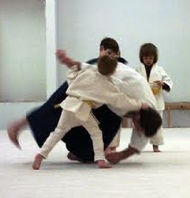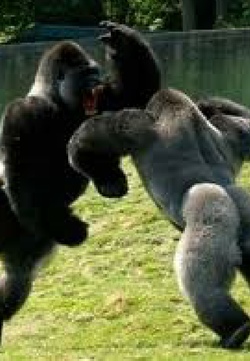

Most Common Randori Training Mistakes
Article Source: http://www.aikidotacoma.org/randori.htm
In 1996 I returned to Aikido/Aikijujutsu and was totally mystified to learn how the Dojo did their randori. Not only had it become almost non-existent but all the black belts were not much better at randori then their white and colored belts.
Randori is the simplest and probably most misunderstood part of Aikido today. “Randori” simply translated means, “full speed, anything goes!” There are no restrictions on speed or type of attacks (anything goes). It is the culmination of all that we train for and truly demonstrates how well you have developed the unification of mind, body, and spirit. There is no other practice in Aikido that can do this.
It seems obvious that in the final analysis only an Aikidoka, who has unified his/her mind, body, and spirit through rigorous Aikido training, would be able to defeat multiple attackers if logical reasoning and diplomacy fail.
The main reason I found randori to be so difficult is really quite simple. The Ukes made no real attempt to hit you or attack you in any manner, but rather they made some kind of slow useless gesture that did not resemble any form of real attack. Always remember this. In randori “the Ukes attacks must be real!” The Ukes, and the Instructors, are not helping the Nage by making half hearted, slow moving attacks that are just plain worthless. The only way you can truly find out how much you have been able to unify mind, body, spirit, and how strong your lead has developed is through real randori. It takes a calm spirit, relaxed mind in control of it self , and a reasonably healthy body to do well in randori, as well as life in general.
There have been several times during our Saturday night randori that I used a pair of Karate sparring gloves when it is my turn to be one of the Ukes. In the beginning I had no trouble hitting everyone there, but the more we practiced randori the better everyone got. The main reason they improved so dramatically is that I was really trying to hit them and break through their defenses. This gave them a taste of the real thing and a chance for us to analyze apparent suki (weaknesses) in their defense/offense. I found that for the most part they rarely made the same mistake a third time. They also realized that even if they were unable to execute a technique, that getting out of the way of the attack was very important, especially when we were doing randori with various weapons.
When the Aikidoka first starts participating in randori, his/her Ashi Sabaki (footwork) and Te Sabaki (hand movement) during the execution of their Aikido techniques are usually very awkward, sloppy, clumsy, poorly timed, and for the most part unsuccessful. When this occurs the first thing usually out of the instructor’s mouth is, “OK everyone slow down.” “WRONG!” Everyone should do more randori.
In lieu of slowing down, there are intermediate practices you can do. Such as;
“Jiju Waza”: This is a form of free style practice that invokes the use of only a specific set of attacks and/or defenses that can be done at various speeds but still employs the use of multiple attackers.
And
“Jiyu Waza”: This is free style attack and defense that is done one on one instead of 2 on 1, or 3 on 1, etc.
Both Jiju and Jiyu Waza will definitely help you develop and improve your skills for randori, but nothing can help your ability to do well in randori except, DOING LOTS OF RANDORI!
I concede that randori can be extremely difficult, very frustrating, and some times even painful ~ but it is always better to take your lumps in the safety of your dojo rather than learning the hard way out on the street.
Outside of the dojo we receive NO second chances.
Article Source: http://www.aikidotacoma.org/randori.htm
The Wheel Throw (Kaiten Nage) by a thousand cuts. Kind of a reverse discrimination randori thing going on here.... I like it.


Meeting force with force. Never a good aikido principle.

2014 - 2021 ngaexperience.com
When the Aikidoka first starts participating in randori, his/her Ashi Sabaki (footwork) and Te Sabaki (hand movement) during the execution of their Aikido techniques are usually very awkward, sloppy, clumsy, poorly timed, and for the most part unsuccessful.
When this occurs the first thing usually out of the instructor’s mouth is, “OK everyone slow down.” “WRONG!” Everyone should do more randori.

Consider “Jiju Waza” as an entry point for Randori Training. Jiju Waza is a form of free style practice that involves the use of only a specific set of attacks and/or defenses that can be done at various speeds but still employs the use of multiple attackers.
A White Belt Jiju Waza example would be limiting ukes’ attacks to the straight punch, and requiring nage to always use a Front Wrist Throw in defense.